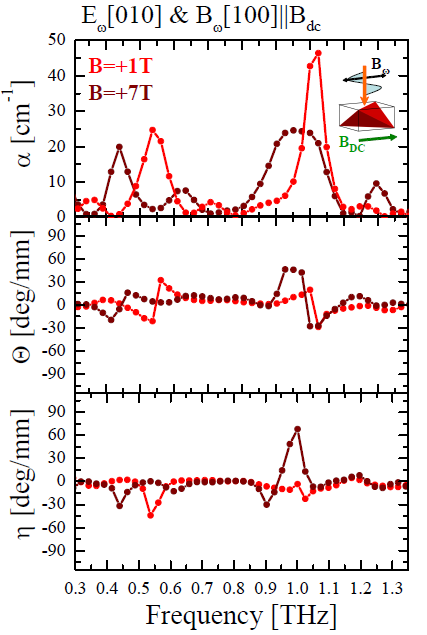 |
BMe Research Grant |

|
PhD School of Physical Science
Department of Physics/Institute of Physics
Supervisor: Dr. István Kézsmárki
Exotic Magneto-Optical Effects in Solids
Introducing the research area
In the course of my PhD research, I study novel magnetic materials – by means of optical spectroscopy – which change the polarization or the color of the transmitted or reflected light. Such magneto-optical materials, in which the fast manipulation of light beam could be realized via external magnetic field, have a broad range of applications from magneto-optical data storage through optical communication.
Brief introduction of the research place
Solid State Physics Laboratory at BUTE investigates the transport, magnetic and optical properties of novel materials often under extreme conditions, such as low temperatures, strong magnetic fields and high pressures. Currently the two main research fields are the physics of nanoscale devices and the optical properties of correlated electron materials [1–7, A, B, C].
History and context of the research
Matter when placed in a magnetic field rotates the polarization of light and makes it elliptical. Chiral materials show similar circular dichroism as discovered in the XIXth century. The former and latter phenomena are called magneto-optical Faraday-effect and natural optical activity, respectively.
|
The counterpart of the Faraday effect in reflection, the magneto-optical Kerr-effect (MOKE) is widely used for the detection of surface magnetization. Magnetic structures, such as magnetic domains, vortices in superconductors [8] etc., can be mapped with micrometer resolution. Owing to the optical detection technology, dynamics of magnetization can be followed in time with picosecond resolution [9], offering a way for generating optically excited magnetic resonance [10], or a real-time investigation method of spin diffusion in semiconductors [11]. |
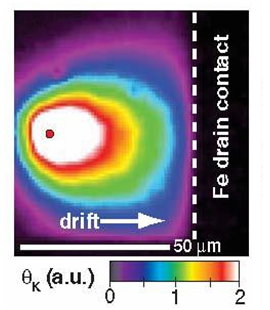 Diffusion of spin-polarized carriers excited by circularly polarized LASER beam in a semiconductor [11]. |

|
Faraday-effect is the consequence of broken time reversal symmetry, while natural optical activity is due to the lack of mirror symmetry. If both symmetries are broken, an interesting new phenomenon, the so-called directional dichroism appears. Absorption of light becomes different for the counter-propagating beams and more importantly, this property can be manipulated by magnetic field [12,13,14]. In contrast to the cases already realized in optical devices, such directional light-switch does work for unpolarized beams, as well. |
Aim of the research
Crystals showing large magneto-optical effects are widely used in optical isolators (Faraday rotators, optical circulators), mode-conversion waveguides and optical data storage. Although directional dichroism phenomenon would offer a large variety of applications, from intelligent solar-coating of windows to telecommunication systems, the effect is hardly observable for usual materials. Therefore, the search for novel compounds with large magneto-optical effects has great technological importance, while understanding the microscopic mechanism behind these exotic effects is a milestone for basic research.
Magneto-optical spectroscopy, when performed over a broad photon-energy range from infrared (E>1 meV) to ultraviolet (E<6 eV), is an excellent method for the characterization of complex spin structures emerging in correlated electron systems and for determining fundamental physical parameters like magnetic exchange interaction, relativistic spin-orbit coupling, crystal-field splittings or other properties of electronic states.
The goal of my PhD work is the investigation of materials showing interesting magneto-optical effects and tailoring of novel compounds with unique properties for optical applications and information technology. The study of such compounds over an extended range of magnetic field and temperature often provides fundamental information about the complex magnetic states and gives a clue for the well-controlled synthesis of new systems.
Methods
High-sensitivity detection of light polarization
High-sensitivity detection of light polarization with a precision of 0.001° in optical rotation and ellipticity can be achieved by polarization modulation techniques. In our magneto-optical setup a photo-elastic modulator (PEM) switches back and forth between the two circularly polarized states with 50 kHz frequency. Correspondingly, the circular birefringence and dichroism of the sample can be detected with Lock-in amplifiers by selecting the appropriate harmonics from the detected light intensity.

High magnetic field, low-temperature MOKE measurement system by which
magnetization can be measured up to 14 T.
|
Broadband magneto-optical spectrometer With extending the energy range of spectroscopy we get better chances to investigate versatile optical phenomena. To determine optical properties – reflectivity, absorption and magneto-optical spectra – over 0.01–6 eV, we integrated a holographic grating monochromator (Oriel 74100) and a Fourier-transform infrared spectrometer (Varian 670-IR). A diffraction grating splits white light into colors, while the Fourier-transform system measures the autocorrelation function of the light by an interferometer and the power spectrum is calculated by Fourier transformation. The polarization modulation technique was easily adapted for the monochromator, while its application in the Fourier-transform system required a delicate methodology. The sampling rate of the autocorrelation function – which determine the high energy cut-off – and the time-constant of the Lock-in amplifiers had to be matched with the PEM frequency. During my PhD course, I participated in the development of the first broadband magneto-optical spectrometer in the Department of Applied Physics at the University of Tokyo. An updated version of this device is under construction in our laboratory. This device is capable of high-sensitivity detection of the magneto-optical Kerr effect and also of the natural optical activity characteristics of chiral structures. |
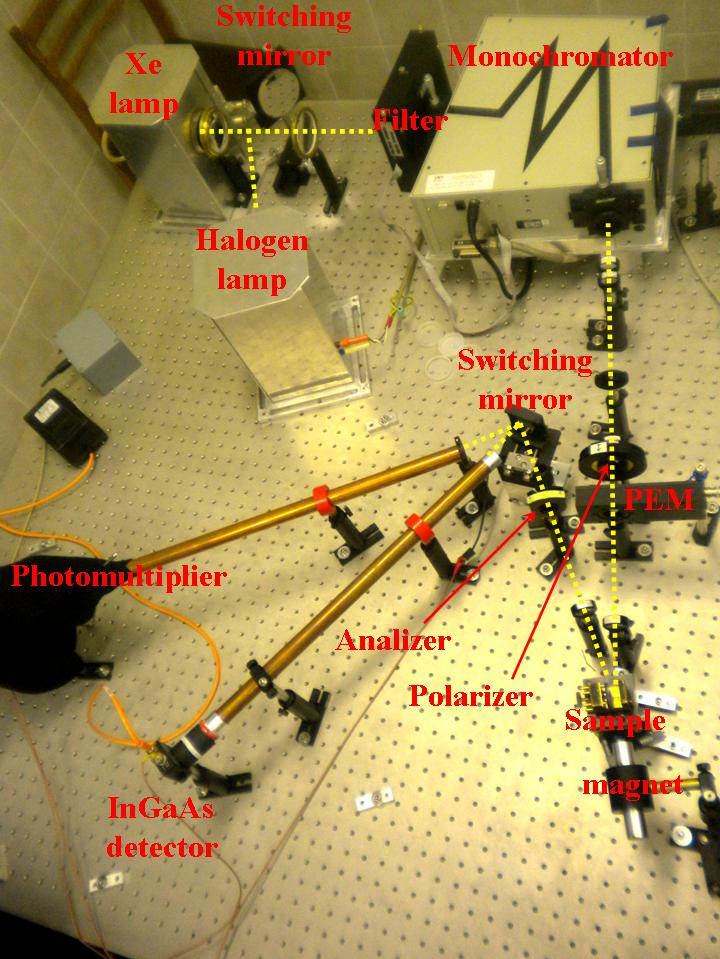 Our magneto-optical spectrometer developed for the near infrared to ultraviolet region (E=0.8–6eV). |
|
Time-domain terahertz spectroscopy Recent development of terahertz spectrometers, operating in the energy range between the microwaves and infrared, attracted much interest, since non-ionizing long-wavelength radiation is advantageous in medical applications, material sciences and telecommunication as well [15]. | ||
|
Results
|
Dilute magnetic
semiconductors Doping semiconductors with magnetic ions without phase-segregation is a basic requirement for the integration of magnetic data storage and semiconductor-based information technology. I performed magneto-optical Kerr-effect measurements on several magnetic semiconductors – (In,Mn)Sb, (In,Mn)As and (Ga,Mn)As – in high magnetic fields. The results clarify the mechanism of magnetic interaction between Mn ions and the typical magnetic cluster size in these systems [D]. |
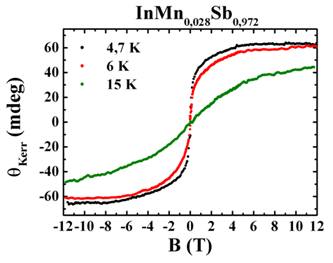 Magneto-optical Kerr-effect of In0.972Mn0.028Sb thin film in high magnetic field [D]. |
|
Ferrimagnetic spinels The spinel crystal CoCr2O4 is a ferrimagnet with several magnetic sublattices. Lack of inversion symmetry for Co2+ ions makes the transition between their d orbitals optically allowed. For these excitations we have found the largest, θ=12°, magneto-optical Kerr rotation observed so far in insulating magnets. We extended our research to other compounds of the same family (substituting Co with Cu and Fe) which also exhibit large magneto-optical signal at low temperatures. As chalcogenide spinels are already ferromagnetic at room temperature, they have a potential for various technology applications if a similarly high magneto-optical effect is achieved [E]. |
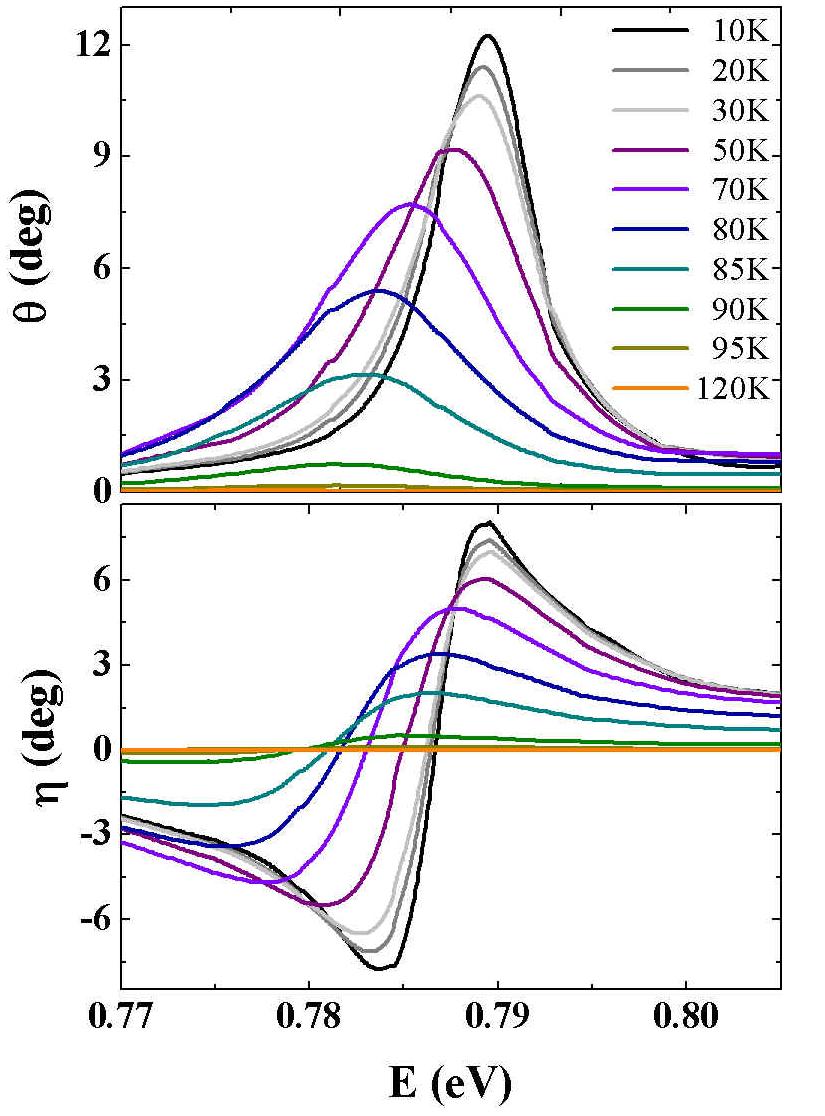 |
Determination of spin-polarized band structure in itinerant ferromagnets is challenging from both experimental and theoretical side and would help in the synthesis of completely spin-polarized conductors. For several metals we could deduce the accurate spin-polarized electronic structure from simultaneous measurements of absorption and magneto-optical spectra [E, F, G], as demonstrated for CuCr2Se4. Interaction of localized Cr3+ spins and itinerant charge carriers leads to an almost completely spin-polarized Fermi surface in this material [E].

Determination of spin-polarized band structure for absorption and magneto-optical spectra in CuCr2Se4 [E].
|
Directional dichroism in multiferroic Ba2CoGe2O7 Ba2CoGe2O7 is ferrimagnetic below TN=6,7 K and simultaneously, it is ferroelectric. These materials, termed multiferroics, show interesting cross-correlation effects: magnetization can be manipulated by applying electric field, whereas ferroelectric polarization can be switched by magnetic field. |
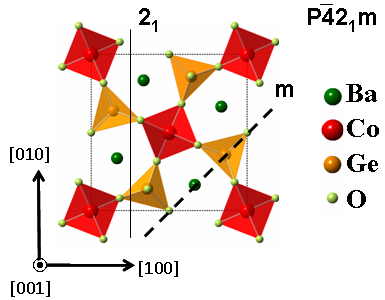
|
|
Absorption and natural
optical activity spectra of
Ba2CoGe2O7. |
The optical analogue of this
magneto-electric effect is the both magnetically- and electrically-active
spin
wave excitation, the so-called electromagnon. By polarization dependent terahertz
spectroscopy we proved that the sharp absorption at 1 THz in
Ba2CoGe2O7 is an electromagnon, for which
we found giant directional dichroism. External magnetic field applied along the [100] or [010] direction induce chirality in Ba2CoGe2O7 and the spin-wave excitations show natural optical activity. According to our knowledge, this is the first example when natural optical activity is reported for magnons – it has been observed only for charge excitations and lattice vibrations.
|
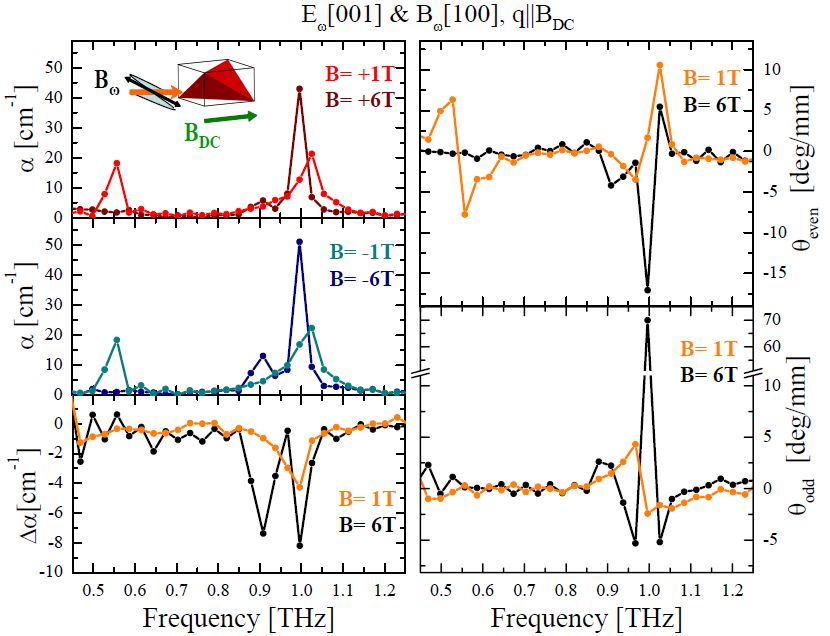
Magnetically-induced chiral phase exhibits huge directional dichroism (left panel). Absorption of electromagnon excitation changes by 40% for light propagating parallel and antiparallel to the magnetic field. Lack of inversion and time reversal symmetry is indicated by the presence of optical activity and Faraday-effect, respectively (right upper and lower panels).
Expected impact and further research
I participated in the development of a broadband magneto-optical spectrometer that is an effective tool for studying new magnetic compounds. My results show that magneto-optical spectroscopy provides fundamental information about complex magnetic orders in solids and the underlying interactions. I am going to extend the investigation of electromagnon excitation in such multiferroic materials which exhibit exotic magneto-optical effects (directional dichroism and field-induced chirality) in the microwave and terahertz region even at room temperature.
I am a coauthor of 9 articles, 7 of them are related to optical spectroscopy and published in high-impact journals such as Physical Review Letters and Applied Physics Letters.
Publications, references, links
[A] I. Kézsmárki I, S. Bordacs: An
alternative of spectroscopic ellipsometry: The double-reference method
Applied Physics
Letters 92, 131104 (2008)
[B] I.
Kézsmárki, R. Gaál, C. C. Homes, B. Sipos, H. Berger, S. Bordács, G. Mihály, L.
Forró: High-pressure infrared spectroscopy: Tuning of the low-energy
excitations in correlated electron systems
Physical Review B
76, 205114 (2007)
[C] S. Bordacs, D. Varjas,
I. Kézsmárki, G. Mihaly, L. Baldassarre, A. Abouelsayed, C. A. Kuntscher, K.
Ohgushi, Y. Tokura: Magnetic-Order-Induced Crystal Symmetry Lowering in
ACr2O4 Ferrimagnetic Spinels
Physical Review
Letters 103, 077205 (2009)
[D] G. Mihály, M. Csontos, S. Bordács, I. Kézsmárki, T. Wojtowicz, X. Liu, B. Jankó and J. K. Furdyna: Anomalous Hall Effect in the (In,Mn)Sb Dilute Magnetic Semiconductor Physical Review Letters 100, 107201 (2008)
[E] S. Bordács, I. Kézsmárki, K. Ohgushi, Y. Tokura: Experimental band structure of the nearly half-metallic CuCr2Se4: An optical and magneto-optical study New Journal of Physics 12, 053039 (2010)
[F] N. Hosaka, H. Yamada, Y. Shimada, J. Fujioka, S. Bordács, I. Kézsmárki, M. Kawasaki and Y. Tokura: Magneto-optical characterization of the ferromagnetic-paramagnetic phase boundary in the composition-spread epitaxial film of Sr1-xCaxRuO3 Applied Physical Express 1, 113001 (2008)
[G] S. Iguchi, S. Kumakura, Y. Onose, S.
Bordács, I. Kézsmárki, N. Nagaosa and Y. Tokura: Optical probe for anomalous
Hall resonance in ferromagnets with spin chirality
Physical Review
Letters 103, 267206 (2009)
Szilárdtestfizika
Laboratórium, Fizika Tanszék, BME
Tokura & Onose Laboratory, Department of Applied Physics, University of Tokyo
[1] Kézsmárki István: Magneto-optikai spektroszkópia a modern szilárdtestkutatásban.: – avagy a
látható mágnesség (Magneto-optical spectroscopy in contemporary solid-state physics – magnetism made visible, published in Hungarian), Magyar Tudomány 2009/7 (2009)
[2] I. Kezsmarki, Y. Tomioka, S. Miyasaka, L. Demko, Y.
Okimoto, Y. Tokura: Optical phase diagram of perovskite colossal
magnetoresistance manganites near half doping Physical Review B
77, 075117 (2008)
[3] I. Kezsmarki, G. Mihaly, R. Gaal, N.
Barisic, A. Akrap, H. Berger, L. Forro, C. C. Homes, L. Mihaly: Separation of
orbital contributions to the optical conductivity of BaVS3 Physical Review
Letters 96, 186402 (2006)
[4] I. Kezsmarki, Y.
Shimizu, G. Mihaly, Y. Tokura, K. Kanoda, G. Saito: Depressed charge gap in the
triangular-lattice Mott insulator
kappa-(ET)2Cu2(CN)3 Physical Review B
74, 201101 (2006)
[5] I. Kezsmarki, G.
Mihaly, R. Gaal, N. Barisic, H. Berger, L. Forro, C. C. Homes, L. Mihaly: Pressure-induced suppression of the spin-gapped insulator phase in BaVS3: An
infrared optical study
Physical Review B
71, 193103 (2005)
[6] I. Kezsmarki, S.
Onoda, Y. Taguchi, T. Ogasawara, M. Matsubara, S. Iguchi, N. Hanasaki, N.
Nagaosa, Y. Tokura: Magneto-optical effect induced by spin chirality of the
itinerant ferromagnet Nd2Mo2O7
Physical Review B
72, 094427 (2005)
[7] I. Kezsmarki, N.
Hanasaki, D. Hashimoto, S. Iguchi, Y. Taguchi, S. Miyasaka, Y. Tokura: Charge
dynamics near the electron-correlation induced metal-insulator transition in
pyrochlore-type molybdates
Physical Review
Letters 93, 266401 (2004)
[8] M. Terao, Y. Tokunaga, M. Tokunaga, T. Tamegai: Observation of single vortices by magneto-optical imaging Physica C 421-431 94 (2005)
[9] http://awsch-web.physics.ucsb.edu/
[10] S.A. Crooker, G. D. Rickel, A. V. Balatsky, D. L. Smith: Spectroscopy of spontaneous spin noise as a probe of spin dynamics and magnetic resonanace Nature 431 49 (2004)
[11] S. A. Crooker, M. Furis, X. Lou, C. Adelmann, D. L. Smith, C. J. Palstrom, P. A. Crowell: Imaging spin transport in lateral ferromagnet/semiconductor structures Science 309 2191 (2005)
[12] G. L. J. A. Rikken, E. Raupach: Observation of magneto-chiral dichroism Nature 390 493 (1997)
[13] L. D. Barron: Magnetic molecules: chirality and magnetism shake hands Nature Matrials 7 691 (2008)
[14] B. B. Krichevtsov, V. V: Pavlov, R. V. Pisarev, V. N. Gridnev: Spontaneous non-reciprocal reflection of light from antiferromagnetic Cr2O3 J. Phys. Condens. Matter 5 8233 (1993)
[15] M. Tonouchi: Cutting-edge terahertz
technology Nature
Photonics 1 97 (2007)


